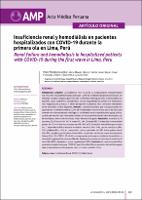| dc.contributor.author | Meneses-Liendo, Victor | |
| dc.contributor.author | Medina Chávez, Mario | |
| dc.contributor.author | Gómez Lujan, Martín | |
| dc.contributor.author | Cruzalegui Gómez, Cesar | |
| dc.contributor.author | Alarcón-Ruiz, Christoper A. | |
| dc.date.accessioned | 2023-11-28T15:35:30Z | |
| dc.date.available | 2023-11-28T15:35:30Z | |
| dc.date.issued | 2022-02-04 | |
| dc.identifier.citation | Acta Médica Peruana. 2023; 38(4). | es_PE |
| dc.identifier.uri | https://hdl.handle.net/20.500.12959/4561 | |
| dc.description.abstract | Antecedentes y objetivo: La insuficiencia renal es una de las complicaciones extrapulmonares más frecuente en pacientes hospitalizados con COVID-19 condicionando peores desenlaces. Sin embargo, estudios comparan pacientes con insuficiencia renal aguda (IRA) o crónica (ERC) con pacientes sanos. Determinar características clínicas de pacientes con COVID-19 e insuficiencia renal hospitalizados y evaluar el efecto del tipo de insuficiencia renal y el recibir hemodiálisis en los desenlaces clínicos negativos. Métodos: Cohorte descriptiva que incluyó pacientes con algún tipo de insuficiencia renal y COVID-19 hospitalizados durante marzo y julio del 2020, que tuvieron una interconsulta con nefrología. La insuficiencia renal se clasificó como aguda, crónica, y crónica en estadio V con hemodiálisis crónica. Se recolectó información sobre mortalidad, uso de inotrópicos, ventilación mecánica y recibir hemodiálisis aguda. Resultados: Se analizó a 279 pacientes, 22.6 % tenían IRA, 33.3 % tenían ERC, y 44.1 % tenían ERC V. Se describe una mortalidad general de 32.9 %. Entre los pacientes con IRA y ERC el 12.9 % recibió hemodiálisis por primera vez. El desarrollo de IRA se asoció a ventilación mecánica (RPa: 6.46), uso de inotrópicos (RPa: 7.02) y fallecer (RPa: 2.41), en comparación con los que tenían sólo ERC. Entre quienes tenían IRA o ERC, aquellos que recibieron hemodiálisis por primera vez tienen mayor prevalencia de fallecer (RPa: 2.95; IC95%:2.20 a 3.94) en comparación con los que no recibieron hemodiálisis. La hemodiálisis aguda podría ser un modificador de efecto de la asociación entre tipo de insuficiencia renal (IRA o ERC) y desenlaces clínicos negativos (p<0.001). Conclusión: Es importante identificar a pacientes hospitalizados por COVID-19 que desarrollan IRA y/o necesitan hemodiálisis aguda pues se encuentran en alto riesgo de tener una mala evolución clínica. | es_PE |
| dc.description.abstract | Introduction: Kidney failure is one of the most frequent extrapulmonary complications in patients hospitalized with COVID-19, leading to poorer outcomes, and this may have serious consequences for the Peruvian health system. Nonetheless, there are studies comparing patients with acute kidney failure (AKF) and chronic kidney failure (CKF) against healthy subjects. Objective: To determine the clinical characteristics of hospitalized patients with COVID-19 and kidney failure, and to assess the effect of the type of kidney failure and undergo hemodialysis with respect to negative clinical outcomes. Methods: This is a descriptive cohort study that included patients with some kind of kidney failure and COVID-19 who were hospitalized
between March and June 2020, and who had a consultation with the nephrology service. Kidney failure was classified as acute, chronic, and stage V chronic undergoing chronic hemodialysis. Data with respect to mortality, inotrope use, mechanical ventilation, and acute hemodialysis was collected. Results: Two-hundred and seventy-nine patients were included, 22.6% had acute kidney failure, 33.3% had chronic kidney failure, and 44.1 had stage V chronic kidney failure. General mortality rate was 32.0%, and 27% received inotrope agents and underwent mechanical ventilation. Amongst patients with AKF and CKF, 12.9% underwent hemodialysis for the first time. Studied adult subjects with CKD and stage V CKD undergoing hemodialysis had lower frequency of diabetes mellitus (23.7% and 43.9%, respectively) and high blood pressure (31.2%
and 59.4%, respectively) compared with adult subjects with AKF (81.0 and 73%, respectively) (p<0.001). The occurrence of AKF was associated with mechanical ventilation (RPa: 6.46), inotrope use (RPa: 7.02), and death (RPa: 2.41), compared with those who had CKF. Amongst those subjects who had AKF or CKF, those who underwent dialysis for the first time were more likely to die (RPa: 2.95; 95% CI: 2.20–3.94) compared with those who did not undergo hemodialysis. Acute hemodialysis may be an effect modifier for the association between the type of kidney failure (AKF or CKF) and negative clinical outcomes (p<0.001). Conclusion: It is important to identify hospitalized patients with COVID-19 that may develop AKF and/or who may need acute hemodialysis, since they are at high risk for a poor clinical outcome. | es_PE |
| dc.format | application/pdf | es_PE |
| dc.language.iso | spa | es_PE |
| dc.publisher | Colegio Médico del Pérú | es_PE |
| dc.relation.uri | https://amp.cmp.org.pe/index.php/AMP/article/view/2169 | es_PE |
| dc.rights | info:eu-repo/semantics/openAccess | es_PE |
| dc.rights.uri | https://creativecommons.org/licenses/by-nc-sa/4.0/ | es_PE |
| dc.subject | Insuficiencia renal | es_PE |
| dc.subject | Covid-19 | es_PE |
| dc.subject | Dialisis renal | es_PE |
| dc.subject | Renal Failure | es_PE |
| dc.subject | Renal Dialysis | es_PE |
| dc.title | Insuficiencia renal y hemodiálisis en pacientes hospitalizados con COVID-19 durante la primera ola en Lima, Perú | es_PE |
| dc.title.alternative | Renal failure and hemodialysis in hospitalized patients with COVID-19 during the first wave in Lima, Peru | es_PE |
| dc.type | info:eu-repo/semantics/article | es_PE |
| dc.subject.ocde | https://purl.org/pe-repo/ocde/ford#3.02.20 | es_PE |
| dc.identifier.doi | https://doi.org/10.35663/amp.2021.384.2169 | |









